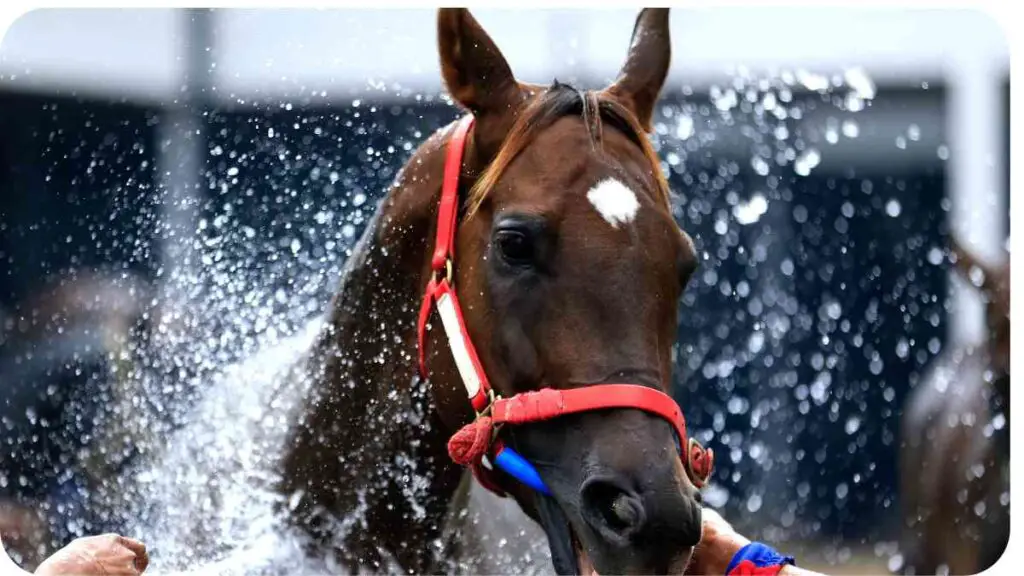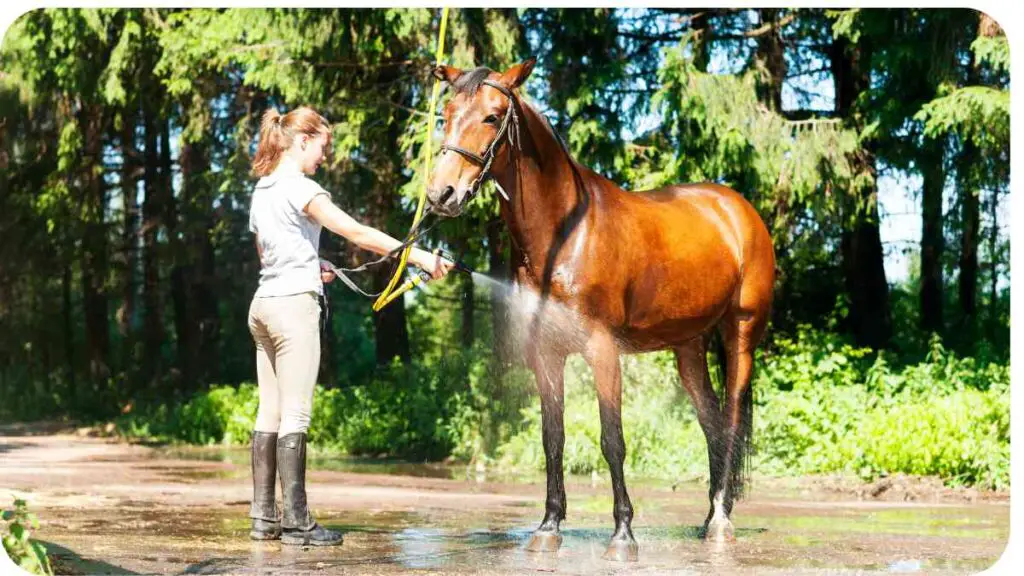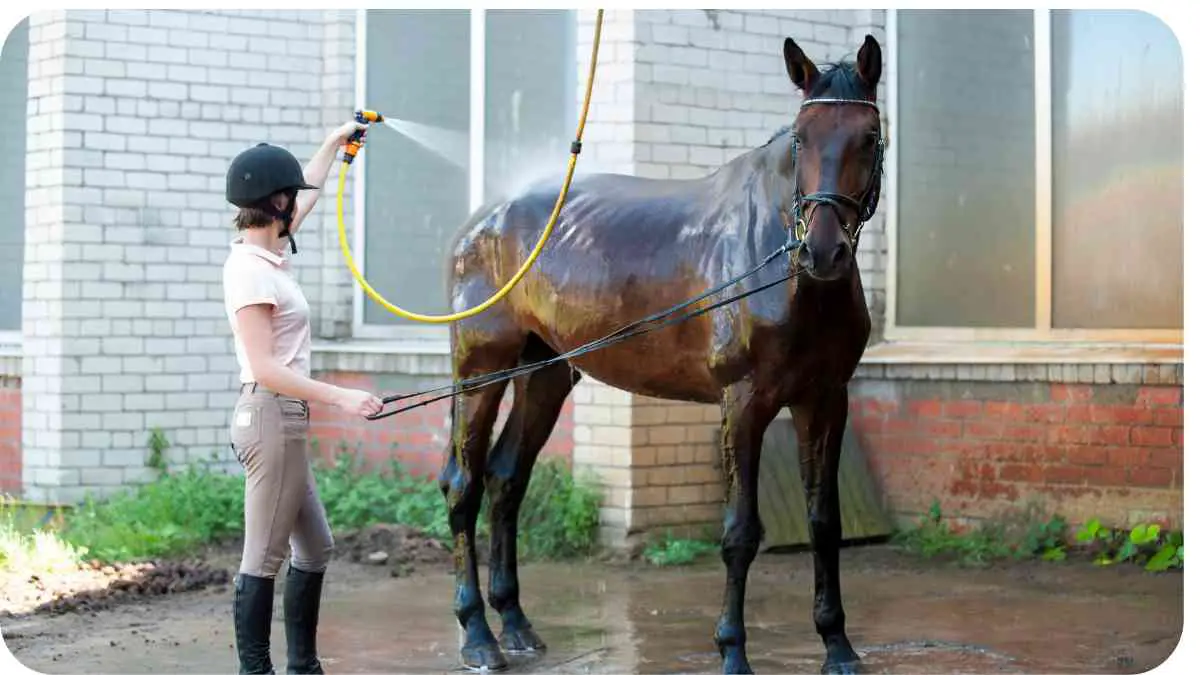As equestrians, we understand the importance of taking care of our horses to ensure their well-being and longevity. One often overlooked aspect of horse care is the cooling down process after a ride. In this article, we will explore the significance of cooling down your horse, its physiological benefits, and practical tips for incorporating a proper cooling down routine into your equestrian practice.
| Takeaways |
|---|
| Cooling down your horse after exercise is crucial for their well-being and performance. |
| Gradually reducing exercise intensity and incorporating walking and stretching aid in the recovery process. |
| Proper cooling down promotes enhanced muscle recovery and reduces inflammation and swelling. |
| Cooling down helps maintain joint and tendon health and regulates body temperature. |
| The use of appropriate equipment, such as cooling blankets and fans, can enhance the cooling down process. |
| Adapting your cooling down routine to different weather conditions ensures optimal comfort and well-being for your horse. |
| Cooling down also plays a role in injury prevention and has a positive impact on overall performance. |
2. The Basics of Cooling Down
Before delving into the specifics, let’s start with a brief overview of what it means to cool down your horse. Cooling down refers to a post-ride routine that gradually reduces the intensity of exercise and helps restore your horse’s body to its pre-exercise state. It involves incorporating low-intensity exercises, such as walking and stretching, which aid in the recovery process.
Understanding your horse’s body language is crucial for a successful cooling down process. By learning their cues, you can ensure a safe and effective post-ride routine.
3. Understanding the Physiology of Cooling Down
To fully grasp the importance of cooling down, it’s essential to understand the physiological effects it has on your horse’s body. When horses exercise, their muscles generate heat, and their blood vessels dilate to improve circulation. This increased blood flow delivers essential nutrients and oxygen to the muscles, allowing them to perform optimally.
After exercise, if your horse is abruptly brought to a halt, the sudden reduction in physical activity can cause blood to pool in the extremities, preventing the efficient removal of waste products. Cooling down helps prevent this by gradually reducing the intensity of exercise, facilitating the continued removal of waste products from the muscles.
4. Benefits of Cooling Down Your Horse

Enhanced Muscle Recovery
Cooling down promotes enhanced muscle recovery by aiding in the removal of metabolic waste products, such as lactic acid, from the muscles. This helps prevent muscle soreness and stiffness, allowing your horse to recover more quickly between workouts.
When it comes to equestrian equipment, it’s essential to know what’s necessary. This guide on equipment essentials will help you streamline your cooling down gear.
Reduction of Inflammation and Swelling
Proper cooling down can help mitigate inflammation and swelling in your horse’s muscles, tendons, and joints. By gradually decreasing the intensity of exercise, your horse’s body has an opportunity to naturally cool down, reducing the risk of excessive inflammation and associated discomfort.
Maintenance of Joint and Tendon Health
Cooling down helps maintain the health of your horse’s joints and tendons. By gradually reducing exercise intensity, the stress on these structures is minimized, allowing them to recover and rejuvenate more effectively.
Regulation of Body Temperature
During exercise, your horse’s body temperature increases. Cooling down aids in restoring their body temperature to normal levels. Proper temperature regulation is crucial for your horse’s overall well-being and can help prevent overheating or hypothermia.
Prior to hitting the trails, understanding proper horse riding etiquette is a must. Explore this guide on trail riding etiquette to ensure a smooth and respectful cooling down experience.
Facilitation of Waste Removal
Through the gradual reduction of exercise intensity, cooling down allows waste products, such as carbon dioxide and metabolic byproducts, to be efficiently removed from your horse’s muscles. This helps improve overall muscle function and reduces the risk of adverse effects caused by the accumulation of waste.
5. How to Cool Down Your Horse Properly

Now that we understand the importance of cooling down, let’s explore some practical tips on how to cool down your horse properly.
Gradual Reduction of Intensity
After a workout, it’s crucial to gradually decrease the intensity of exercise. Start by transitioning from a canter or trot to a slower pace, such as a walk. This allows your horse’s heart rate and breathing to return to normal gradually.
Effective horse cooling down also involves managing their pasture. Discover essential tips for maintaining a suitable environment for your horse’s post-ride relaxation.
Incorporating Walking and Stretching
Walking plays a significant role in the cooling down process. Aim for at least 10 to 15 minutes of walking, allowing your horse to relax and catch their breath. Additionally, incorporate some stretching exercises to help loosen the muscles and increase flexibility.
Correct Post-Ride Care
Once you’ve completed the cooling down exercises, it’s important to properly care for your horse. After untacking, make sure to remove any sweat using a sweat scraper or towel. Excess moisture left on the coat can prevent effective cooling and potentially lead to muscle stiffness.
Afterward, consider giving your horse a refreshing bath, particularly in warm weather, to aid in body temperature regulation. Always ensure the water is not too cold or too hot, as extreme temperatures can stress your horse’s system.
6. Avoiding Common Mistakes
While cooling down is essential, it’s equally important to avoid some common mistakes that may hinder the effectiveness of the process. Avoid abruptly stopping exercise, as this can cause a buildup of blood in the extremities. Also, refrain from cooling your horse down in a drafty area or exposing them to sudden changes in temperature, as it could lead to muscle tension or illness.
Although not directly related, understanding equine sleep patterns can indirectly impact horse health, including their cooling down process. Learn about equine sleep patterns to improve your horse’s recovery.
7. Equipment for Cooling Down
You can enhance the cooling down process by utilizing various equipment specially designed to aid in temperature regulation and promote muscle recovery.
Cooling Blankets
Cooling blankets are made from materials that absorb moisture and help dissipate heat from your horse’s body. These blankets are particularly useful during warm weather or after intense workouts to facilitate the cooling process.
Cooling Mats
Cooling mats provide a comfortable surface for your horse to rest on while aiding in the dissipation of heat. They are often made from materials that naturally cool when pressure is applied, offering relief and soothing sensations to your horse.
Cooling Fans
In hot and humid climates, cooling fans can be an effective tool to circulate air and help regulate your horse’s body temperature. Place the fans strategically in the stable or turnout area to provide continuous airflow during the cooling down process.
8. Best Practices for Cooling Down in Different Weather Conditions
Adjusting your cooling down routine based on weather conditions ensures optimal comfort and well-being for your horse. Let’s explore the best practices for cooling down according to various weather conditions:
Hot Weather
During hot weather, it’s essential to pay close attention to your horse’s body temperature to prevent overheating. Increase the duration of walking and incorporate more shaded areas for rest. Utilize cooling blankets and apply cool water to your horse’s body, focusing on the neck, chest, and legs for effective heat dissipation.
| Hot Weather Cooling Tips |
| Increase walking time during the cooling down process |
| Utilize cooling blankets to aid in temperature regulation |
| Apply cool water to your horse’s body |
| Focus on areas with high heat dissipation, such as neck, chest, and legs |
Cold Weather
In cold weather conditions, it’s crucial to avoid sudden changes in body temperature that may lead to muscle tension or discomfort. Gradually decrease the intensity of exercise and consider using a cooler or a lightweight blanket to prevent your horse from cooling down too rapidly.
| Cold Weather Cooling Tips |
| Gradually decrease exercise intensity |
| Use a cooler or lightweight blanket to maintain body warmth |
Wet Weather
When cooling down your horse in wet conditions, pay attention to potential chilling caused by dampness. Utilize moisture-wicking materials for coolers or blankets to ensure effective drying and prevent unwanted cooling.
| Wet Weather Cooling Tips |
| Utilize moisture-wicking materials for blankets |
| Ensure effective drying to prevent unwanted cooling |
Humid Weather
Humidity can aggravate the effects of heat on your horse’s body. In humid weather, adjust your cooling down routine by providing additional shaded areas and frequent breaks during the cooling process. Utilize cooling fans to facilitate airflow and enhance the evaporation of sweat.
| Humid Weather Cooling Tips |
| Provide additional shaded areas and breaks during cooling down |
| Utilize cooling fans to enhance the evaporation of sweat |
9. The Impact of Cooling Down on Performance
The benefits of cooling down extend beyond the immediate recovery of your horse’s body. Implementing a proper cooling down routine can have a significant impact on your horse’s overall performance and well-being.
By incorporating a thorough cooling down process into your routine, you help prevent muscle stiffness and soreness, allowing your horse to be ready for their next training session sooner. This regular practice promotes better muscle development and strength over time.
Moreover, cooling down helps establish a positive association with the end of a workout. By incorporating relaxation and stretching exercises, you create a calming and soothing experience for your horse, enhancing their mental well-being.
Furthermore, cooling down plays a crucial role in injury prevention. By gradually reducing exercise intensity and allowing your horse’s body to recover, you minimize the risk of strains, sprains, and other injuries. This, in turn, leads to fewer setbacks in your training and competition goals.
Conclusion
Cooling down your horse is a vital aspect of their post-workout routine, ensuring their overall well-being, performance, and longevity in the equestrian world. By gradually reducing exercise intensity, incorporating walking and stretching, and utilizing appropriate equipment, you facilitate efficient recovery, muscle development, and injury prevention.
Remember to adapt your cooling down routine to different weather conditions, providing additional measures such as cooling blankets, fans, or moisture-wicking materials. By understanding the importance of cooling down and implementing these practices into your equestrian routine, you enhance your horse’s comfort, health, and performance.
So, the next time you finish a training session or a ride, take the time to properly cool down your horse. Your equine partner will appreciate the care and attention, and you’ll reap the benefits of a healthier and happier horse.
Now that you have all the information you need to implement a proper cooling down routine, get out there and enjoy the ride!
Further Reading
Here are some additional resources for further reading on the importance of cooling down your horse:
- FEI: 3 Steps to Cooling Down Your Horse: This article provides a step-by-step guide to effectively cooling down your horse after exercise. Learn about the importance of gradual reduction of intensity and incorporating walking and stretching exercises.
- Petplan Equine: Warming Up & Cooling Down: Explore the importance of both warming up and cooling down your horse in this comprehensive article. Discover tips and techniques to properly cool down your horse to prevent muscle stiffness and promote recovery.
- SmartPak: How to Cool Down a Horse After Riding: This resource provides valuable insights into the various methods and equipment available to effectively cool down your horse. Learn about cooling blankets, walking routines, and post-ride care.
FAQs
What is the purpose of cooling down your horse?
Cooling down your horse allows their body temperature, heart rate, and breathing to gradually return to normal levels. It facilitates muscle recovery, waste removal, and can aid in injury prevention.
How long should the cool-down period be?
The cool-down period should last for at least 10 to 15 minutes. This duration allows your horse’s body to gradually recover and return to a relaxed state.
Should I cool down my horse in hot weather?
Yes, it is especially important to cool down your horse in hot weather to prevent overheating. Ensure proper hydration and utilize cooling techniques such as applying cool water or using cooling blankets.
Can I use a cooler or lightweight blanket during the cooling down process?
Yes, using a cooler or lightweight blanket can help maintain your horse’s body warmth in cooler weather. It prevents them from cooling down too rapidly and potentially becoming chilled.
Are there any specific stretches I should incorporate during the cool-down period?
Yes, stretching exercises can be beneficial during the cool-down period. Focus on gentle stretches that target the neck, back, and legs to help promote flexibility and prevent muscle stiffness.

Hi there! My name is Hellen James, and I’m a horse riding expert. I’ve been riding horses since I was just a kid—and it’s been my passion ever since. But getting started with horse riding can be overwhelming. There’s so much to learn! If you’re looking for a way to get started and make sure you’re doing it right, I’m here to help.


